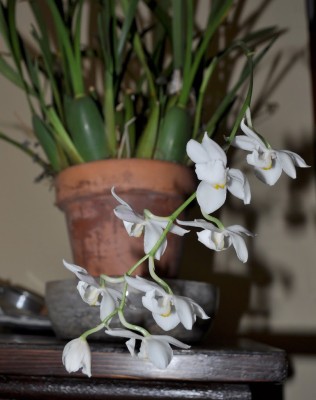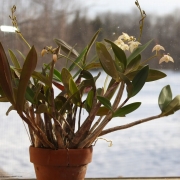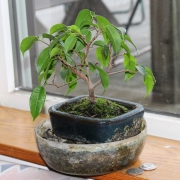Orchid Intimidation
Fear Not
I used to find orchids intimidating to grow. Their dust-sized seeds are fairly unique in not having any food reserves so — in the wild, at least — need the help of a fungus partner to get growing. And some orchids (epiphytes) spend their lives nestled in trees so need a special potting mix when grown in a pot. Orchids have above-ground structures called pseudobulbs. And many, especially those that call humid, tropical forests their homes, demand exacting environmental conditions that are very different from that found in most homes. Whew!
So I steered clear of growing any orchid for many years — until a local orchid enthusiast gave me a plant. After a couple of years, that plant, around this time of year, sent up a slender stalk which was soon punctuated with eight waxy, white flowers, each an inch across. For two months, those flowers greeted me each morning with their beauty and their delicious fragrance. Every year since, that plant has greeted me for weeks in midwinter.
Odontogl . . . a Mouthful
My orchid has no common name so needs to be referred to by its botanical mouthful, Odontoglossum pulchellum. (Even orchid names are intimidating, especially so because different genera have often been hybridized, and the resulting hybrid combines the generic names of the parents. So a hybrid with Brassavola, Laelia, and Cattleya in its parentage would have the name Brassolaeliocattleya. Now that’s a mouthful!)
Name notwithstanding, my Odontoglossum pulchellum has been easy to grow and get to flower.  The plant spends summers outdoors in semi-shade near the north wall of my house, and winters indoors on a sunny windowsill. I water it perhaps twice a week, unless I forget.
The plant spends summers outdoors in semi-shade near the north wall of my house, and winters indoors on a sunny windowsill. I water it perhaps twice a week, unless I forget.
Sounds like your run-of-the-mill houseplant, doesn’t it? So much for orchids being difficult.
The only special treatment my plant gets is a special potting mix. Odontoglossum pulchellum is an epiphytic orchard. Commercial potting mixes are available for epiphytic orchards but I make my own by mixing equal parts of my standard (home made) potting mix with equal parts wood chips. Nothing special about the chips; I just scoop them up from the pile that I use mostly for mulch that an arborist kindly dumps next to my woodshed every year.
Every spring I divide my orchid plant into 2 or 3 new plants, potting each new plant into its own pot with fresh potting mix.
More Orchids?
Odontoglossum pulchellum is an orchid that tolerates being treated like your average houseplant. And this is one of the most important points in growing orchids in a house: choose a sort that thrives in such an environment. Other orchids that will grow in the average home include phalaenopsis, paphiopedilums, and mini-catts, which are dwarf hybrids involving Cattleya (the corsage orchid).
Ideally, for flowering at least, certain conditions must be met. Most orchids enjoy bright light, which means setting the plant at an east, west, or south windowsill. From spring through autumn, light from a south window is too intense and may scorch foliage, so plants need to be protected with a thin gauze curtain, or moved to other windows or semi-shade outdoors.
Most orchids — again, for flowering — enjoy a ten to fifteen degree temperature difference from day to night, which is no problem in winter if you heat with a wood stove or already turn the thermostat down at night to conserve fuel. In the summer, the plant needs to be outdoors or else in a room that is not air-conditioned.
Even those orchids adapted to a home environment benefit from increased humidity. I raise the humidity around my plants by perching the flowerpot above a water-filled tray. Clustering plants together is another way to raise the humidity near plants, and also creates a visual lushness.
Once correctly sited, many orchids do not require inordinate amounts of care. Water requirements vary, but species with thickened pseudobulbs (bulbous stems), such as my Odontoglossum, get by with the least frequent watering. Orchid roots are susceptible to fertilizer burn, so the rule in feeding is to do it frequently and lightly. As with other houseplants, some orchid species take an annual rest, and at such times watering and feeding should commensurately diminish.
Since “mastering” the growing of one orchid, I have acquired another kind. This orchid is Dendrobium kingianum, which does go under the more user-friendly common name of pink rock orchid. I have also gotten this one to flower — but not every year.
This orchid is Dendrobium kingianum, which does go under the more user-friendly common name of pink rock orchid. I have also gotten this one to flower — but not every year.




When I lived in Maine, a fellow employee who frequently entered her houseplants in contests told me she had never grown orchids! I told her she absolutely must because they are not as difficult to grow as many people think. She went on to become president of the Maine Orchid Society and has a very impressive orchid collection. I just love that. Meanwhile my own collection has diminished but for a few survivors that are now retired in Florida and living in hanging baskets outside. I hope to regrow it.
Thank you for this post. I had the same experience – whenever someone gave me an orchid it was a one-time bloom thing and then dead – until five or six years ago and I’m not sure how I learned to keep them going – I now have 8 or 10 that bloom year after year – I think I was watering them too much before and not fertilizing enough. I’ve never re-potted because I thought they want to be crowded in their pots. But I am inspired to do so by your post. Most if not all of mine are moth orchids. I do not take them outside and they are in a sunny “garden” room all year round. They do not seem to mind the summer sun inside. I have read they don’t like air conditioning but they sometimes have no choice. It is one of my most rewarding gardening successes.
Excellent encouragement. Especially on the dividing!!!